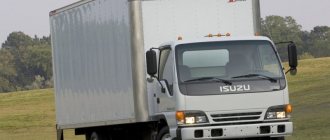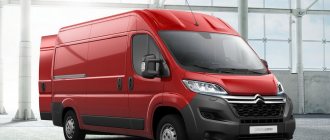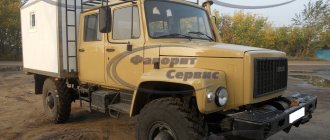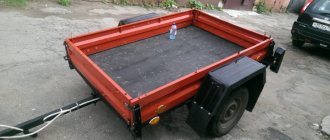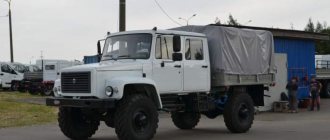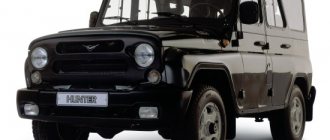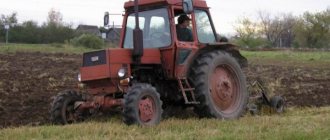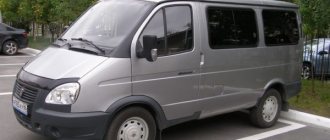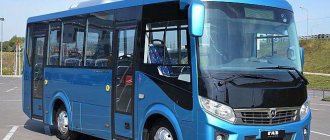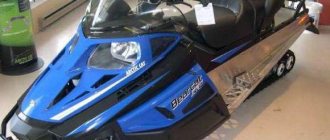Isuzu Elf is a series of Japanese middle class trucks. The first models of the line appeared in 1959. Initially, the technology was focused exclusively on the Asian market and Oceania. In the 1980s, cars began to be exported to the United States. Around the same time, the model appeared in European countries. The Isuzu Elf name was used exclusively for the domestic market; export versions became known as the Isuzu N-series.
- The first generation was presented in August 1959 and was a small 2-ton truck. It was created to meet the transportation needs of local consumers. The debut version of the Isuzu Elf was produced in a huge number of modifications (flatbed trucks, tanks, minibuses, double-cab models and others).
- In 1967, the second generation of Isuzu Elf was released. In addition to the global update, the series has become wider. The company has developed an ultra-light truck - the 1.25-ton Isuzu Light Elf.
- Since 1975, the production of the third generation of Isuzu Elf began, represented by 2 main versions (150 and 250). The model was still focused on the domestic market. After another 6 years, the car underwent a slight restyling, retaining recognizable features.
- In the summer of 1984, the Isuzu Elf 4 premiered. This generation spread throughout the world. It is noteworthy that the fourth Isuzu Elf can still be found on the road today. The model was assembled in various countries, including the USA and China. The main ones for the version were 2.5-liter 4JA1 diesel engines.
- In July 1993, the fifth generation of the Isuzu Elf debuted with a revised design, and 5 years later a gas version appeared. In 2004, the model received another update: the radiator grille, headlights and bumper underwent changes. Isuzu Elf has become more interesting and modern, while maintaining its main features: maneuverability and functionality.
- In 2006, production of the 6th generation of Isuzu Elf began, represented by 2 variations (High Cab/Wide Cab). A year later, version 3 (Regular Cab) was added to them. The design of the car has been completely updated, and the equipment has undergone significant changes.
- Currently, the 7th generation of the model is available, the premiere of which took place relatively recently.
For the Russian market, Isuzu Elf is assembled at the SOLLERS-ISUZU joint venture, located at the production facilities of UAZ (Ulyanovsk).
Briefly about the manufacturer
The Isuzu-Elf, the technical characteristics of which we will consider further, became the first production vehicle of its segment produced in Japan. Isuzu, named after the river, was founded in 1916. The final name “Isuzu Motors” was assigned to the company only in 1949. The first conveyor vehicles were “passenger cars”, and the first trucks came out in 1918.
Subsequently, the manufacturer significantly strengthened its position in the domestic and foreign markets. This happened largely thanks to large government orders from the country's trade ministry. With the help of the state, the corporation began developing its own engines. Soon, Japan's first atmospherically cooled diesel engine was produced at the production bases of this company.
Links[edit]
- [1] Archived January 7, 2010 at the Wayback Machine.
- "Chinese car brands that time forgot: AF Auto Trucks". www.facebook.com
. Retrieved December 26, 2022. - "ISUZU: Major Overseas Subsidiaries, Branches and Offices". www.isuzu.co.jp
. Retrieved September 7, 2022. - ^ a b
"Isuzu deslocaliza produção de Vendas Novas para Itália".
Transportes & Negócios
(in Portuguese). February 13, 2014. Retrieved December 26, 2019. - “Pabrik Mobil Isuzu di Karawang Rp 1.7 Triliun Resmi Beroperasi” [1.7 trillion Isuzu vehicles at the Karawang plant are officially operational]. Detik Finance
(in Indonesian). detikcom. April 7, 2015. Archived from the original on August 9, 2022. - LEITH, JAMES P. "Thursday is the last day of production as Isuzu line comes to an end". gazettextra.com
. - https://www.ccjdigital.com/isuzu-celebrates-20000-unit-milestone-for-n-series-gas-powered-cabover/
- Ozeki Kazuo (2007). 日本のトラック・バス 1918–1972 [ Japanese trucks and buses 1918-1972.
] (In Japanese). Tokyo: Miki Press. paragraph 68. ISBN 978-4-89522-494-9. - Ozeki, page 52
- Ozeki, page 53
- Nagayama, Koji (永山浩二) (2009), いすゞ『エルフ』50年史 [50th Anniversary of Isuzu "Elf"
] (PDF) (in Japanese), Japan Society of Automotive Engineers (JSAE), page 1 - Jump up
↑ Ishikawa, p. 75 - Ozeki, page 55
- Ozeki, pp. 64-65
- ^ a b c
Ishikawa, page 68 - "いすゞTLシリーズマイクロバスの系譜(いすゞ編_1)" [Genealogy of the Isuzu TL Series Minibus (Isuzu First Edition)] (in Japanese sk language). 403 Forbidden. Retrieved January 12, 2014.
- ^ a b c d
Nagayama, page 2 - ^ a b自動車ガイドブック
[
Japan Automobile Guide 1978/1979
] (in Japanese),
25
, Japan: Japan Automobile Manufacturers Association, October 10, 1978, p. 131, 0053-780025-3400 - Jump up
↑ Ishikawa, p. 77 - ^ a b
Ishikawa, page 71 - ^ a b
Ishikawa, page 72 - "Beijing LAC China" [Beijing LAC (China)]. Books and Catalogs (Books and catalogs
). Behind the wheel. Archived from the original on August 19, 2011. - 牛汉华 (Niu Han Hua) (March 29, 2012). 高效城市物流 8 款高端蓝牌轻卡车型推荐 [Eight Effective Guidelines for Trucks for Urban Logistics].卡车之家 [House of Trucks]
(in Chinese). - Meyer, Donald E. (March 2009), "The First Century of GMC Truck History" (PDF), GM Heritage Center
, General Motors, page 38 - Meyer, page 39
- ^ a b
Mel, Jim (July 1990).
"New Models for 1991: Midsize Trucks." Fleet owner
. Vol. 85 no. 7. Business publications FM. pp. 69–70. - Mele, page 71
- Stark, Harry A., ed. (1987). 1987 Ward's Automotive Yearbook
.
49
. Detroit, MI: Ward's Communications, Inc. p. 175. ISBN 0910589007 .CS1 maint: ISBN errors ignored (link) - Ward's Automotive Yearbook 1987
, page 258 - “Chevrolet alcanza el récord de 20.000 camiones armados en Chile” (in Spanish). General Motors. June 19, 2008. Archived from the original on February 14, 2009.
- "GM Returns to Medium-Duty Truck Market, Partners with Isuzu". www.autonews.com
. June 15, 2015. Retrieved July 24, 2022.
First generation (1959-1965)
Below are the technical characteristics of the first generation Isuzu-Elf (TL-221):
- machine weight – 2 tons;
- engine – 1.5 liter petrol engine, 60 hp. With;
- wheelbase – 2.18/2.64 m;
Since 1960, a two-liter diesel engine with a power of 52 hp was installed on the car. With.
A light truck with a diesel engine, the GL-150, became the first light-duty Japanese car to run on diesel fuel. Many companies soon followed the example of this manufacturer, including Chinese, American and German corporations. From the very first generation, Isuzu focused on the versatility of its machines. Flatbed versions, tanks, minibuses, dump trucks and vans were produced on the standard chassis.
"Minuses"
The most common problem arises with the suspension, which on Russian roads, especially in the provinces and on inter-yard sections, is beyond criticism.
The second, related to Russian conditions, is the need to frequently replace such a part of the fuel system as diesel injectors due to low-quality diesel fuel or the wrong brand. A particularly common reason for injector failure is the use of specialized diesel fuel for ship engines among Far Eastern residents and residents of port cities. Which still differs in its parameters from those recommended on the ISUZU ELF website.
Poor location of the fuel injection pump and fuel filter - at the bottom. Craftsmen undertake to move it upstairs. Which immediately increases maintainability.
Weak sensors. You need to be especially careful with the coolant temperature sensors - they may not work and the radiator fan may not turn on in time, which can lead to complete engine failure.
The high price of a new car, which does not quite correspond to the declared technical characteristics.
However, one can argue with the last claim: it is no secret that in our conditions, owners of Isuzu elves often neglect and overload the advice and direct instructions recommended by the manufacturer. For example, a 3 and a half ton car up to a total weight of 5 tons!
Yes, he will. Repeatedly. And then serious problems will appear with the suspension or even with a fairly rigid frame (cracks and deformations will appear). And who is to blame? Well, of course, the Japanese! Didn't foresee...
"Average":
In general, they note the reliability of the machine even in the basic configuration, provided that the technical design and declared service life correspond to the operating conditions.
Second and third generations
The technical characteristics of the Isuzu-Elf in the second generation have not changed dramatically when compared with its predecessor. The load lifting rate has increased to 2.5-3.5 tons. The useful volume of the standard power unit using diesel fuel was 1.6 liters, power - 75 liters. With. The design of the cabin has also changed slightly.
For the third generation of the machine in question, several modifications of diesel engines were developed:
- Elf-150 – 2 l, 62 l. With;
- modification 250 “Super” - 3.3 l (100 hp);
- "Vaid-350" - 3.9 l (110 hp).
In addition, there were a number of intermediate “diesels”, as well as a standard gasoline version. The carrying capacity ranged from 1.5 to 3.5 tons. The exterior and interior of the vehicle underwent changes.
Chassis options
Considering the technical characteristics of the Isuzu Elf chassis, it should be noted that the following parameters are practically identical:
- Suspension - spring
- The brakes are hydraulic, with ESC, ABS and ASR are included. Brake type – disc
- Transmission SUZU MYY5M, 5-speed
- Frame spacing – 700 mm
- Front axle load limit – 2,100 kg
- Rear axle load limit – 2,435 kg
- Fuel tank with a capacity of 75 or 100 liters depending on the vehicle configuration
- Mains voltage 24 v
- Generator 24.3 v with charging current 90 A
About
4th and 5th series
The characteristics of the Isuzu-Elf in its latest version did not particularly change the essence of the car. It has remained a reliable, practical, versatile and inexpensive light-duty truck. This series was sold all over the world, but in some countries the car was released under other names. In parallel with this generation, the development of powerful analogues with increased carrying capacity “Forward” was carried out. The fourth generation received a new diesel engine with a 2.5-liter SNVT system.
The fifth version of the truck in question came out with an updated design and an upgraded engine. The car has remained just as popular on all continents. Thanks to their impeccable reputation, vehicles were produced under the names of such brands as Mazda and Nissan. A 2.7-liter diesel engine was installed as a power unit.
Sixth generation
In this generation, the characteristics of the Isuzu Elf (photo above) with 3- and 5-liter engines have significantly improved in environmental terms. The design was brought to modern ideas about the appearance of the corresponding cars. The new model engines were distinguished by their low weight, reduced harmful emissions into the atmosphere and economical fuel consumption.
By optimizing the design of power units, it was possible to significantly reduce noise. Along with improved engineering design, the overall weight of the vehicle has also been reduced. The load capacity parameter was 1.5-3 tons.
Modern lineup
The updated image of the car received a stylish, deliberately angular configuration, as well as huge blocky light elements. The design of the truck is simple and concise, which became the reason for its copying by Chinese truck manufacturers. The modern model range includes eight modifications, differing in weight, dimensions, cabin and number of drive wheels. For example, the all-wheel drive Isuzu-Elf-NPS-85 model, whose characteristics are close to the “middle” class, is equipped with a wide cabin, and weighs as much as six tons.
The manufacturer positions its updated trucks in the seventh generation as “environmentally friendly” vehicles. The line includes versions with LPG engines. The fuel used is liquefied and compressed natural gas. Power – 125 and 120 “horses”. Most of these cars are equipped as standard with a proprietary manual transmission unit, the switching of which does not require the participation of the clutch pedal. Versions with an automatic transmission with the possibility of mechanical switching are also sold.
How to decipher the alphanumeric designation of the Isuzu Elf modification
In the designation of numerous modifications of modern Isuzu Elf cars, the first letter N indicates the light class of LDT trucks, the second - the total weight: L - from 3.5 to 5 tons, M - from 5 to 7.5 tons, P - from 7.5 to 9.5 tons; Moreover, on cars of both first series a cabin with a width of 1770 millimeters is used. The letter in the third position indicates the wheel formula - as a rule, there is R, which means the car has rear-wheel drive. All-wheel drive versions that are not officially supplied to Russia have the letter S at this marking location. Next, the model (or index) of the car’s engine is encrypted with a two-digit number. The numbers may be followed by the letter A, indicating an independent front suspension, as well as: E (short wheelbase) or H (long wheelbase). For example, the NMR85H is a vehicle with a gross weight of 5 to 7.5 tons with a 4JJ1 engine and a wheelbase length of 3201 to 3500 mm.
Isuzu Elf cars, which were assembled in Russia, were designated not as “N-series trucks”, but as “name + gross weight in tons.” For example: Elf 3.5; Elf 5.2. The same designation remains for the new Elfs sold in our country, imported from abroad (trucks of this family are not currently assembled in Russia).
Description and technical characteristics of “Isuzu-Elf-3.5”
In this version, the machine has a total weight of 3.5 tons and a load capacity of 1,650 kg. The truck is designed for use in the city and suburbs as a delivery transporter. On the market, cars are sold with diesel power plants in accordance with Euro-4 and Euro-5 requirements.
A turbine diesel engine includes four cylinders arranged in a row. Other motor parameters:
- volume – 2.9 l;
- EGR system;
- power indicator - 124 hp. With.;
- speed – 2,600 rpm.
In the Euro-5 configuration, the engine is supplemented with a redesigned fuel system and an additional neutralizer in the exhaust unit of the car. The engine interacts with a gearbox of a mechanical configuration (five modes) with the ability to connect a power take-off unit. There are two wheel bases – 2,490 or 3,350 mm. The dimensions of the truck are 6,020/1,855/2,185 and 4,735/1,855/2,185 mm, respectively. Ground clearance – 19 cm, wheel track – 1,475/1,425 (front/rear).
History of creation
The Isuzu Elf light-duty cargo truck appeared on the assembly line in 1959. It was a two-ton truck labeled Isuzu Elf TL.
In subsequent years, the Isuzu Elf 150 with a load capacity of 1.5 tons and the Isuzu Elf 250 with the ability to transport cargo weighing 2,500 kg were produced.
In 1970, the Isuzu Elf 300 and 350 were launched into mass production, which were capable of carrying cargo with a total weight of up to three and a half tons.
In the nineties of the last century, a lot of work was done to bring these machines up to environmental standards.
Important! Today, Isuzu Elf meets a standard of at least Euro 4. Factories in Japan produced these cars with both hybrid engines and internal combustion engines adapted to run on liquefied gas.
According to the classification proposed by the UN Economic Commission for Europe, these trucks correspond to category N - as motor vehicles with at least four wheels and used for the transport of cargo or as special vehicles.
In Russia, the production of Isuzu Elf is carried out by the SOLLERS-ISUZU joint venture.
The production facilities for assembling these machines are located in Ulyanovsk. Today, various cars of the new modification of the Isuzu Elf 700P generation are produced here.
Features of modification 3.5
This model is presented in the form of a compact and maneuverable truck, built on the basis of a modern universal platform of the P-700 type. The design optimally combines proven technical solutions and the latest technologies. The unified frame makes it possible to mount a variety of superstructure configurations on the chassis, including vans, hydraulic lifts and more.
The car is based on a standard chassis with a spar frame. Suspension type: springs front and rear, reinforced with transverse stabilizers on the front axle. The brake unit is equipped with a hydraulic drive and drums on all wheels. The steering column is equipped with a hydraulic power amplifier. The base includes ABS, ASR, EBD systems. The beauty of the exterior is complemented by halogen optics, fog lights, a reverse buzzer, a heated fuel filter, and an interior heater.
Models 5.2 and 5.5
The base of this modification is the same R-700 platform with a spar-type frame, which is reinforced with several sheets. Due to this, the carrying capacity parameter has increased (3.1 tons). The engine remains the same, but a driving license is already required for C, not B. Other technical. characteristics of "Isuzu-Elf-NKS-58":
- curb weight – 2.1/2.19 kg;
- maximum load front/rear – 1.9/2.7 t;
- fuel tank capacity – 75/100 l;
- tire type – 205/75R16C.
The 5.5 variation is also offered in two wheelbase versions (short and long). The turbine diesel cylinders are placed in-line, the volume is 2.9 liters, the fuel equipment is equipped with electronic injection. Cooling is liquid, there is an additional neutralizer, maximum power is 124 “horses”, maximum torque is 354 Nm. The chassis of the machine is assembled with a rigid spar frame with channels 4 mm thick.
Isuzu Elf 9.5
The flagship model is produced in four versions:
- Shortened wheelbase – 3,815 mm.
- Standard – 3,815 mm.
- Extended version – 4,175 mm.
- "Superlong" - 4,475 mm.
At the same time, the width of the truck is 2.04 meters, height – 2.27 m, length – 6.04/6.69/7.41/7.87, respectively. Other options:
- total weight – 9,500 kg;
- load capacity – up to 6.5 tons;
- axle load – 3.1 t;
- frame type – reinforced side members with channel;
- Fuel tank capacity – 140 l.
It is worth noting that the versatility of the chassis allows you to mount all kinds of superstructures. For example: vans, manipulators, dump trucks, bunker trucks, Isuzu-Elf hole drills. The characteristics of such structures are given below:
- power unit - four-cylinder turbocharged diesel engine;
- power – 155 l. With.;
- torque - 419 Nm;
- working volume – 5,193 cm3;
- transmission – synchronized gearbox with six positions.
Nomenclature[edit]
The Elf is sold as Elf in some non-Japanese markets such as Mexico and Indonesia, but in most export markets it is called the Isuzu N series. The second letter denotes the rated weight, with H
and
K
are used for the regular cab,
M
for the high cab, and
P
,
Q
, and
R
for the wide cab model.
The third letter indicates the transmission pattern; here R
stands for rear-wheel drive and
S
stands for all-wheel drive.
Truck cab
This latest generation unit is a modern cube-shaped cabin with improved aerodynamic parameters. It is more spacious inside than it appears from the outside. The doors open at right angles, the interior design is laconic but well thought out. There are many built-in niches and cabinets for small things and documents. The middle “seat” folds forward, turning into a comfortable table. All these nuances allow you to ensure maximum order in the cabin, placing all the necessary things at arm's length. Good visibility is ensured thanks to the panoramic windshield and large rear-view mirrors.
Reviews of "Isuzu-Elf"
The characteristics of the car determine the positive feedback from owners about it. According to reviews, the truck in question is tough and durable, easy to maintain and rarely requires major repairs. Consumers are also pleased with the simplicity of the design, in particular, the ease of replacing ball joints (which is required after 120-150 thousand km), which is important for domestic roads. Users note that original Isuzu consumables are quite an expensive and difficult pleasure. Options such as air conditioning and heating function perfectly. But the car is not intended for driving outside the city and on dirt roads.
"Pros"
The “Japanese” have traditionally reliable engines, with perfectly compatible on-board computer software that controls all processes in a running car. So Isuzu owners rarely have complaints on this side.
Undoubted advantages also include ideal heat distribution throughout the cabin in the winter cold, excellent visibility and the ability to relax even in the absence of a special sleeping place.
They also note the availability of spare parts anywhere in the country, and even if not, specialized companies send what is needed as soon as possible and at reasonable prices. But here the issue is moot: inexpensive spare parts are only available if you find them in the store directly. One has only to contact the order by mail - the cost jumps by 20-50%.
The cabin has good strength (over 10 years of operation, not a single seam has come apart, not a single rivet has come off), its corrosion resistance.
There are no unnecessary “sophisticated” electronics; all instruments on the dashboard are informative and easy to use. Reliable power steering and easy adjustment to the height and dimensions of the driver.
The ball joints most often “flying” on Russian roads are changed easily and quickly. Unfortunately, the price of original, branded ones is very high. But that’s on to the next part – the “cons”.
